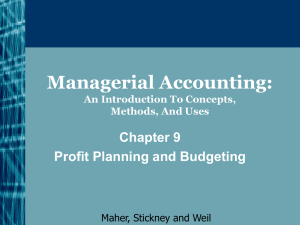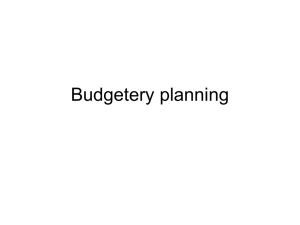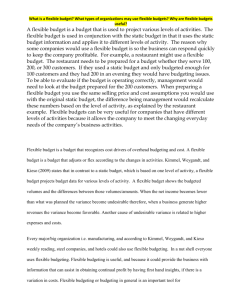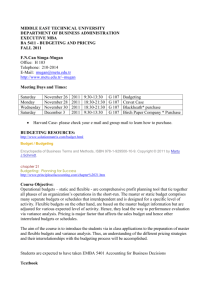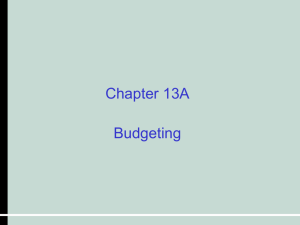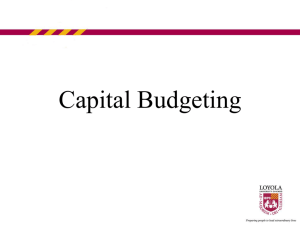What is a budget?
advertisement
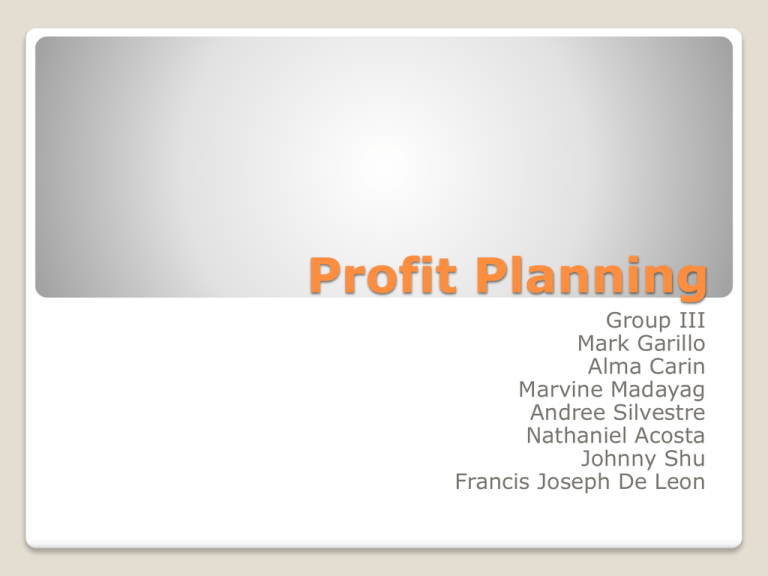
Profit Planning Group III Mark Garillo Alma Carin Marvine Madayag Andree Silvestre Nathaniel Acosta Johnny Shu Francis Joseph De Leon Budget Committee Chairman of the Board Mark Garillo Chief Financial Officer Nathaniel Acosta President Andree Silvestre VP Finance Operation Francis Joseph De Leon VP – Marketing Jhonny Shu VP Sales Marvine Madayag VP Operations Alma Carin Understand the purpose of a budget Understand the processes an organization use to create budget Understand basic budgeting and the behavioural aspects of budgeting Understand the concept of preparing a Master Budget Understand the costs and benefits of budgeting Understand the concept of Flexible budget and activity variance Objectives Quantitative Plan for acquiring and using resources over a specific time period Is a formal expression of plans, goals, and objectives of management. It covers all aspects of operations for a specific time period. What is a budget? Planning Controlling Purpose or uses of budgeting Communicate plans Define goals and objectives Think about and plan for the future Benefits Means of allocating resources Coordinate activities Uncover potential bottlenecks Benefits of budgeting Time consuming and costly Negative employee reactions Costs Limited flexibility Costs of budgeting Unrealistic and inaccurate Natural demand for the project Length of the trade cycle Production cycle Functional areas covered by the budget Need for the control of operations Time necessary for financing production well in advance of actual needs The accounting period Factors for determining budget period Annual budget (a budget prepared for 1 fiscal year). Continuous (Rolling) budget Flexible (Variable) budget -budget prepared for different levels of activity Fixed (Static) budget – budget based on one level of activity Long range budget – more than 1 year Types of budgets Bottom-up Budgeting Top-down Budgeting Top Management Top Management Middle Management Middle Management Lower-level Management Lower-level Management Budget process Normally used by government agencies, universities and organizations relaying on allocated funds. Any unused funding at the end of the financial period cannot be carried out forward to the following year As a result, following year’s budget may be cut because of the under-expenditure in the previous year. Budget Lapsing It helps ensure that appropriate level of resources is utilized. Without budget lapsing the, risk-adverse manager may unnecessarily accumulate funds and this may adversely affect the performance of the organization It helps provide an opportunity for a clean cut-off of expenditures and to reallocate any unused resources for other more appropriate requirements Budget lapsing: Advantages Can cause undesired behavior effects. ◦ E.g. Managers may wastefully spend their entire budget before the end of the period in order to avoid budget cuts A system of reviewing the expenditures near end of the period my uncover unnecessary expenditures and discourage manager to wastefully spend because of budge lapsing Budget lapsing: Potential Problem and Solution Incremental Budget -is budgeting based on slight changes from the preceding period's budgeted results or actual results. (based on historical data) Zero-based budget starts from a "zero base" and every function within an organization is analyzed for its needs and costs Incremental vs. Zero-based budget Budget Com Members President Vice President – in charge of various functions (Sales, Production, Marketing, Procurement or SC and the Controller) Managers involve in the budget planning Budget Com Responsibilities Overall policy matters relating to budget program. Coordinate the preparation of the budget Resolving disputes related to the budget Approving the final budget What are the roles and responsibilities of the budget committee Sales Forecast Production Budget Material usage and purchases Direct labor costs Selling, administrative, and other expenses Cost of goods sold Ending inventory levels Manufacturing overhead costs Cash budget Financial Position and Statement of Cash Flows Capital Expenditure Income statement Steps in formulating a Master Budget Master budget interrelationship It consist of number of separate but interdependent budget that formally lay out the company’s sales, production and financial goals What is master budget How to Generate the Master Budget? 1st Identify the last year’s actual sales 2nd Identify the process for budgeting The board of directors will set the target sales for the specific year Then it will send to the COO and set the meeting to Finance, Marketing, and Advertising Heads Who will sell? How do we sell? Send to Marketing for proper sub division of the set budget Example: 10B / 5 Division = 2B in each Division Marketing Manager Marketing Group 1 Marketing Group 2 Marketing Group 4 Marketing Group 3 Marketing Group 5 QUOTA In a monthly basis They will check the inventories if sufficient, and if not??? Set the meeting with Construction Team and Business Development Team Formulate strategies Set the meeting with the Treasury for proper funding How do we capitalize: Construction? Either we set: Collection Bonds Bank Financing A. Operating budget 1. Sales budget/forecast 2. Production budget a) Material purchase and usage b) Direct labor costs c) Factory overhead costs d) Inventory levels 3. Cost of goods sold budget 4. Selling and administrative expense budget 5. Other expense related budgets B. Financial budget 1. Cash (forecast) budget a) Cash receipt b) Cash disbursement 2. Budgeted income statement 3. Budgeted balance sheet 4. Budgeted statement of cash flows C. Special budget 1. Performance budgets 2. Cash budgets Sub-parts of Master Budget Flexible Budget and Performance Analysis Group III Mark Garillo Alma Carin Marvine Madayag Andree Silvestre Nathaniel Acosta Johnny Shu Learn the concept of Flexible budget and variance Prepare a flexible budget. Prepare a report showing activity variances. Prepare a report showing revenue and spending variances. Prepare a performance report that combines activity variances and revenue and spending variances. Learning Objectives Static Planning (or fixed) budget – a budget based on one level of activity. Flexible Budget – a budget based on different levels of activity. Types of Budget Static Planning (or fixed) budgets are prepared for a single, planned level of activity. Performance evaluation is difficult when actual activity differs from the planned level of activity. Comparing static planning budgets with actual costs is like comparing “apples and oranges”. Flexible budgets show costs that should have been incurred at the actual level of activity, enabling “apples to apples” cost comparisons. Types of Budget Deficiencies of Static Budget Deficiencies of Static Budget Deficiencies of Static Budget Relevant Question – “How much of the cost variances is due to higher activity, and how much is due to cost control?” Deficiencies of Static Budget The most common errors in preparing performance reports are to implicitly assume that – All costs are fixed or that All costs are variable. … Some Common Errors To FLEX a budget we need to know that: ◦ Total variable costs change in direct proportion to changes in activity. ◦ Total fixed costs remain unchanged within the relevant range. Preparing a Flexible Budget Preparing a Flexible Budget

